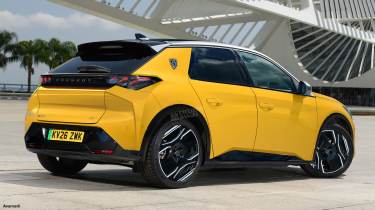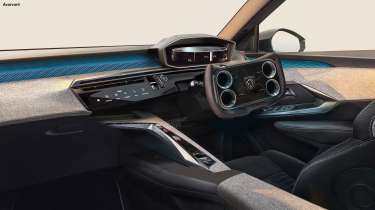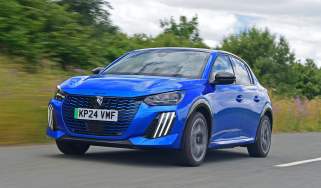New Peugeot 208 to rip up the rulebook with concept car-inspired interior
The new-look Peugeot 208 is set to arrive in 2026, and our exclusive images preview how it could look inside and out
The all-new Peugeot 208, due in 2026, is set to differentiate itself from many of its Stellantis small-car siblings with a radical new look and a move to the company’s new STLA Small platform, Auto Express can exclusively reveal.
The supermini’s premium underpinnings will create clean air between it and cars such as the latest Citroen C3 and forthcoming Fiat Grande Panda, both of which sit on the more cost-focused Smart Car architecture. The 208 will be one of only a handful of models built on STLA Small, possibly including the next-generation DS 3 and Vauxhall Corsa – the latter of which sister manufacturer Opel may insist on in order to maintain its upmarket aspirations in mainland Europe. In common with cars built on the bigger STLA Medium and STLA Large platforms, the 208 will initially launch as an electric car, with the possibility of petrol and hybrid powertrains later, depending on market demand.
We expect the new Volkswagen Polo-rivalling 208 to take design inspiration from the latest 3008 and 5008, and our exclusive images show how the car could look – both inside and out. Following in the footsteps of the newly launched SUVs, expect the 208 to inherit a set of slim headlights and distinctive three-claw daytime-running lights, plus a similarly patterned nose with body-coloured elements that emphasise the supermini’s premium positioning.
The rear end will be recognisable as well, with a dark strip of plastic joining together another set of three-claw light clusters. As is now the fashion, we can expect Peugeot branding to be emblazoned on the back in bold lettering, with smaller ‘208’ badges below. Both of the maker’s most recent SUVs have seen their number plates move from the boot lid to the bumper, and there’s a good chance the forthcoming supermini will follow this trend. Gloss-black detailing will further emphasise the 208’s high-end appeal.
The big news, however, comes inside, where the car will take heavy inspiration from 2023’s Peugeot Inception concept. The sleek four-door was shown at last year’s Consumer Electronics Show, and more recently at VivaTech in Paris – where Auto Express got a chance to catch up with Peugeot design director (and previous concept-car creator) Matthias Hossann.
Core to the 208’s overhauled cabin will be a take on the concept’s Hypersquare steering wheel, which will work in conjunction with the next generation of Peugeot’s i-Cockpit instrument cluster. However, Hossann told us: “I will not call it a steering wheel; it is a new device for driving. But why are we designing that? It’s the ‘by wire’ technology – you don’t have any mechanical connection. It allows us to create a new driving sensation; this is super agile and super efficient.”
It’s a path the French brand has been pursuing for more than a decade with its unique i-Cockpit layout. Every new Peugeot since the original 208 from 2012 has featured this set-up, whereby the driver views the instruments over the steering wheel, rather than through it. Using a downsized wheel that sits lower gives bigger models a small-car feel, instilling what its maker hopes is a darty, fun persona.
Hossann went on to tell us Peugeot is “testing this [new] tech in a prototype” and it’s due within a few years. “We’re developing it,” he said, “and in 2026 we will implement this. It changes everything.”
The squared-off wheel will be much cleaner in its appearance than current offerings, possibly with touchpads to control key functions. The holes you can see in our exclusive image – inspired by those on the Inception concept – will be ergonomically sculpted for what Peugeot deems the perfect driving position. The brand had previously said Hypersquare offers an “entirely natural and universal grip of the steering control”.
“The idea was to generate a much more simple user experience,” Hossann told us. “When you design a race car, you can control all your car with your fingertips, and this is the same idea.”
He allayed any fears about the yoke-style steering wheel limiting the supermini’s usefulness in the urban environment it was conceived for. “It’s super easy,” he assured us. “You need a little time to adapt, but it’s quite quick. We have tested it with a panel of customers. When you come back to a traditional [steering wheel], it feels like you are sitting in a truck.”
However, Peugeot won’t look to go quite as minimalist as Tesla. “This was a big discussion with the engineers,” Hossann said. “We could have decided to put the indicator [on the wheel], but we decided to keep some heritage. We keep some function behind [the wheel], but in terms of shape, it will be really close to this.”
Nestled aft of the wheel will sit an all-new take on the brand’s digital instrument binnacle – possibly based on the Inception’s 360-degree Halo Cluster. Peugeot says this “provides information to the driver and passengers as they approach the car”, offering things such as battery status at a glance. We’ve visualised this in our exclusive image, with the addition of a subtle cowling to protect visibility in direct sunlight.
Elsewhere, we envisage that the new model will use a shrunken version of the latest 3008’s cabin, with a chunky centre console, plenty of angles and sharp design features. It’s not yet clear how the aforementioned, new-look instrument cluster will affect the layout of the central screen; there is a chance Peugeot will choose to integrate it within the main dashboard alongside the Hypersquare-inspired wheel. An alternative would be a pop-up display on top of the dash.
The new 208’s positioning as a more premium model should see the car justify its still-to-be-confirmed price with plusher materials and tighter tolerances. Hossann told us he thought there was “no limit” for where Peugeot can take the brand – bridging the gap between mainstream and luxury with sustainable leather alternatives, brushed metals and textiles for the doors and dash.
It’s unclear at this stage which engines or electric motors may feature. However, we know parent company Stellantis favours a market-dependent multi-fuel approach, and should therefore offer the 208 with a choice of EV and hybrid powertrains. Base models are expected to use a development of the current 1.2-litre petrol unit with hybrid technology. A plug-in is unlikely, given the car’s size; superminis are generally better suited to full electric than heavy PHEV tech.
Speaking of electric, while the new E-208’s battery and motor specs remain resolutely under wraps, it’s fair to assume Peugeot will look to improve on the current car’s stats, giving it greater appeal in myriad markets. That doesn’t necessarily mean fitting a bigger battery, but improved efficiency and faster charging are all but a given. Expect the maker to benchmark a 250-mile range for entry-level cars, with peak charging speeds of more than 100kW.
While the new platform should see the 208 grow in size, the fact it’s been designed for both petrol and EV powertrains may limit outright practicality. Packaging should be competitive, but larger models such as the Skoda Fabia will reign supreme when it comes to boot and passenger space.
With the newcomer’s reveal not expected for at least 18 months, the recently facelifted 208 and E-208 will soldier on until late 2026, possibly early 2027. A new 2008 crossover will inevitably follow, drawing heavily on the supermini’s styling and cabin as well as the new car’s updated powertrain tech.
What do you think of our exclusive images of the new Peugeot 208? Let us know your thoughts in the comments section...










